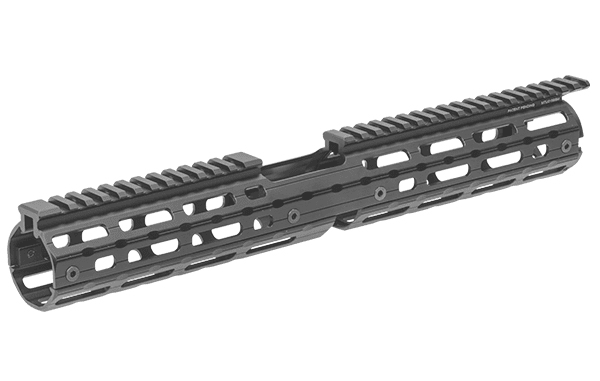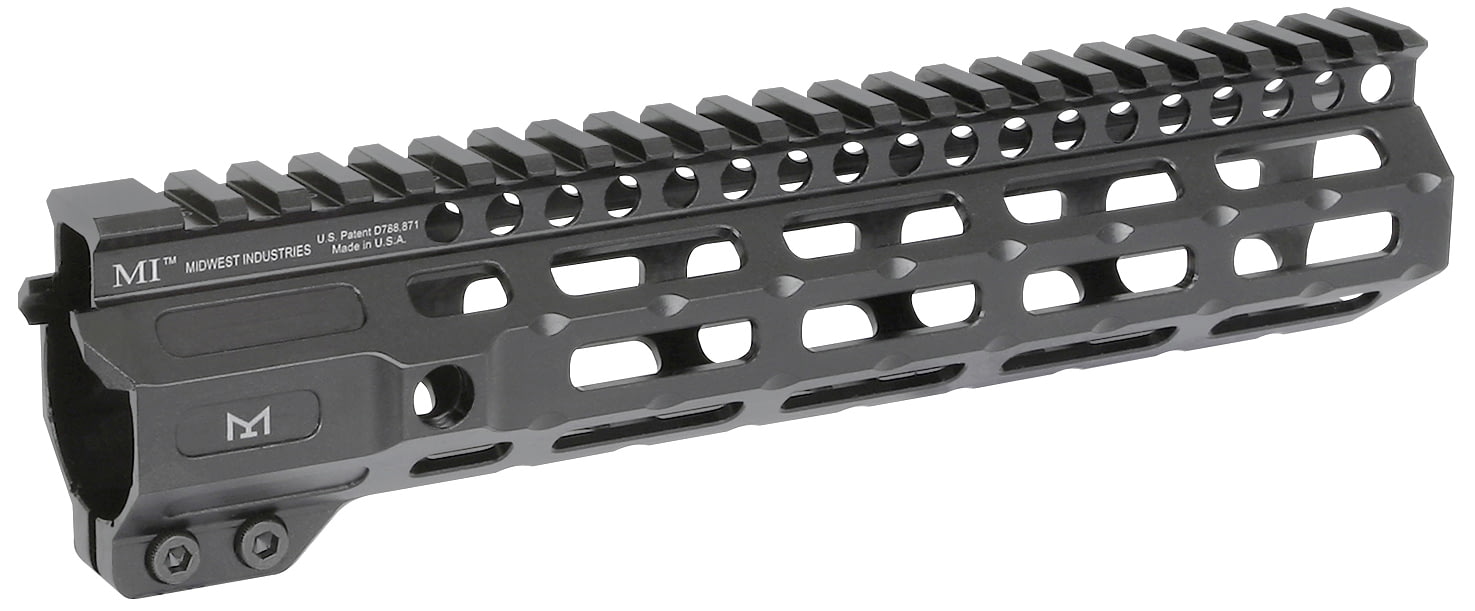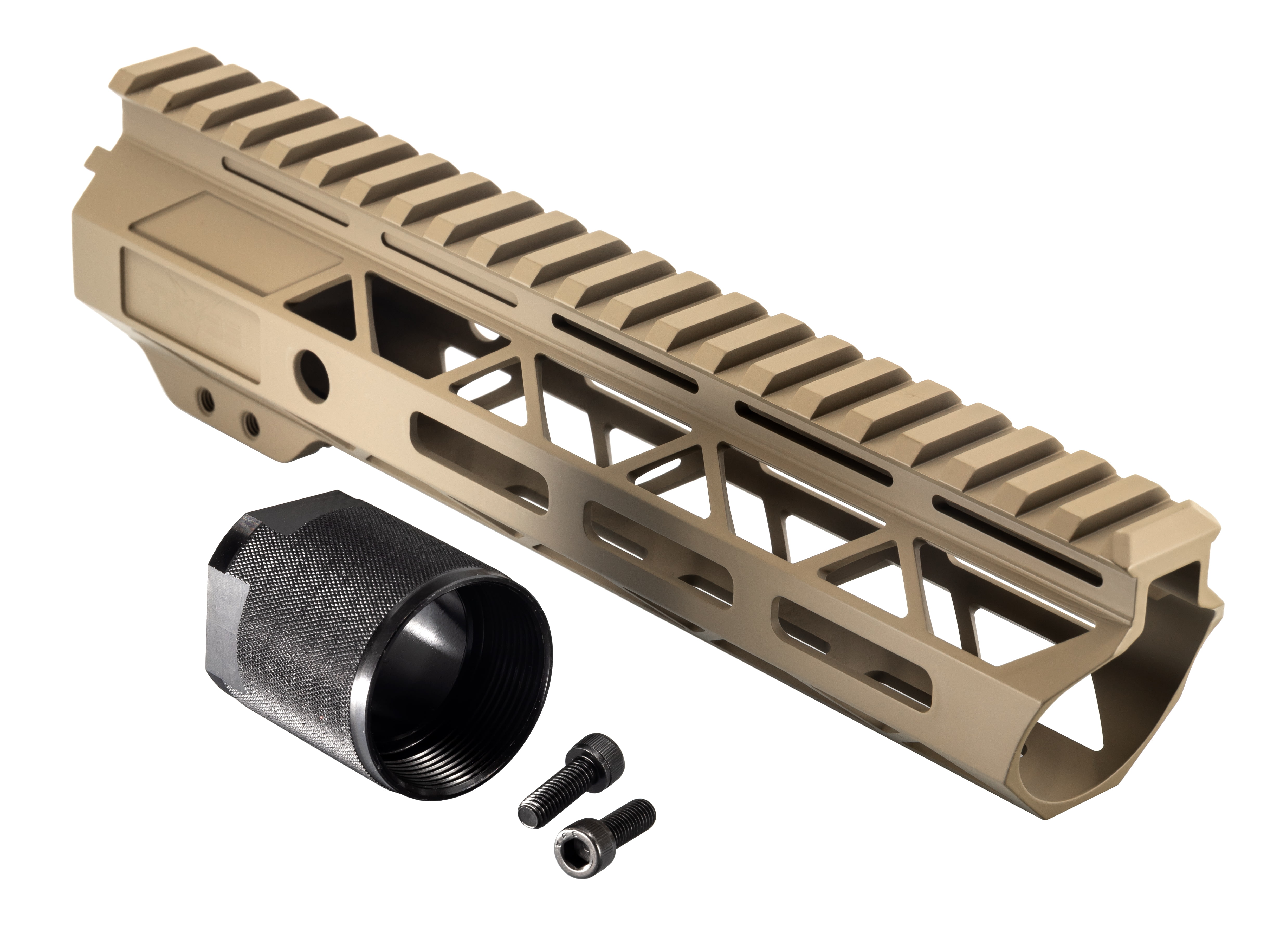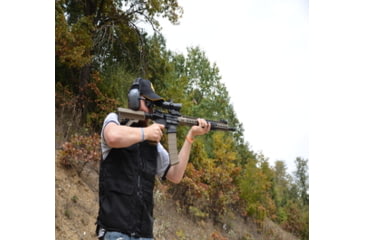The handguard is what covers the barrel and gas tube on an AR platform rifle. They provide a place for your support hand to grip, protecting your hand from the heat generated by the barrel and gas tube while also protecting the barrel and gas tube from being hit and damaged. Most AR handguards offer additional areas to mount accessories such as weapon lights, laser sights, sling mounts, and more. ![]()
There are different types of AR handguards, such as two-piece and free float handguards, but not all handguards are compatible or universal with all types of AR rifles. This guide will help explain the benefits of certain AR15 handguards, as well as common compatibility concerns you may have while selecting a handguard.
How Long Should Your AR Handguard Be?
The correct handguard length is determined by the barrel and gas system length. Gas systems include the gas tube and gas block. The gas system length is generally determined by the barrel length. The most common lengths are:
- Pistol length
- Carbine length
- Mid-length
- Rifle length
Gas system lengths are typically the following:
- Pistol Length gas systems are for barrel lengths of 10in or less
- Carbine Length gas systems are for barrels from 14in-16in
- Mid-Length gas systems are for 16in-18in barrels
- Rifle Length gas systems are for 18in or longer
When choosing a handguard, you want a length that matches the gas system length on your AR-15 without it passing the end of the barrel. If you have a gas block with a Picatinny rail on top or a front sight base, then your handguard cannot cover those and needs to be slightly shorter. Pistol caliber ARs do not use a gas system, so you can have the handguard as short or as long as you want. However, if the handguard extends past the barrel, it can potentially be damaged by gases leaving the muzzle.
Two-Piece Handguards
 Two-piece handguards, also referred to as drop-in handguards, are a top piece and bottom piece that both clamp onto the delta ring near the upper receiver and the front sight gas block. These handguards come in different configurations. Some can have a quad rail, which is four Picatinny rails on each side of the handguard for attaching accessories. There are also plastic two-piece handguards that don’t have any rails but are lighter and offer a smoother surface for the user to place their hand.
Two-piece handguards, also referred to as drop-in handguards, are a top piece and bottom piece that both clamp onto the delta ring near the upper receiver and the front sight gas block. These handguards come in different configurations. Some can have a quad rail, which is four Picatinny rails on each side of the handguard for attaching accessories. There are also plastic two-piece handguards that don’t have any rails but are lighter and offer a smoother surface for the user to place their hand.
The downside to two-piece handguards is that they do not allow for a free-floated barrel. This means that the handguard can put pressure on the barrel when it is being held or when on a rest, which can have some effects on accuracy.
Free-Floating Handguards
 A free-floating, or free-float, handguard is a one-piece handguard that only attaches to the receiver by the barrel nut and covers the gas system. Free float handguards do not make any contact with the barrel, which prevents putting pressure on the barrel when being held or placed on a shooting rest. Another benefit of a free float handguard is the fact that they come in a wide variety of configurations with different rails or attachment types. Handguards can have Picatinny rails, MLOK attachment points, Keymod attachment points, or ARCA Rail attachments.
A free-floating, or free-float, handguard is a one-piece handguard that only attaches to the receiver by the barrel nut and covers the gas system. Free float handguards do not make any contact with the barrel, which prevents putting pressure on the barrel when being held or placed on a shooting rest. Another benefit of a free float handguard is the fact that they come in a wide variety of configurations with different rails or attachment types. Handguards can have Picatinny rails, MLOK attachment points, Keymod attachment points, or ARCA Rail attachments.
These handguards can also have different amounts of rails. For example, there are full-top rail handguards that have a Picatinny rail that extends from the upper receiver. There are also handguards that have mounting rail combinations which usually is a full-length Picatinny rail on top with Keymod or MLOK mounting slots at the 3, 6, and 9 o'clock positions. These allow the user to choose from compatible accessories to mount to their handguard in the desired position.
The downside to having a free float handguard is that if you are switching from a drop-in handguard, you will need to change your barrel nut and gas block. You will also need to make sure the handguard fits over the gas block. Free float handguards also tend to be more expensive than drop-in handguards.
DPMS LR-308 vs Armalite AR10 Handguards
Large-frame ARs are not like AR15s and, for the most part, do not have universally compatible parts, including handguards. The two general types of large-frame AR patterns are Armalite AR10 and DPMS LR-308. The handguards for these types of rifles are not interchangeable, and the barrel nuts for these two types of rifles have different threads. DPMS LR-308 handguards are only compatible with DPMS LR-308 upper receivers, and Armalite AR10 handguards are only compatible with Armalite AR10 upper receivers. However, there are both free-float and two-piece handguard options for both styles of rifles. If you want to see a list of AR10 parts, see this guide.
Choosing the Best Handguard for your AR
 Handguards are an essential part of an AR15 and come in different styles. The style of handguard you choose will depend on your needs. For example, if you are doing competitive shooting or long-range shooting, a free-float handguard will most likely be a better option due to the fact that it is not contacting the barrel and has ability to mount a variety of accessories like optics or bipods. If you are looking for a more budget-friendly rifle that is just going to be used for plinking occasionally, then a two-piece handguard will work fine.
Handguards are an essential part of an AR15 and come in different styles. The style of handguard you choose will depend on your needs. For example, if you are doing competitive shooting or long-range shooting, a free-float handguard will most likely be a better option due to the fact that it is not contacting the barrel and has ability to mount a variety of accessories like optics or bipods. If you are looking for a more budget-friendly rifle that is just going to be used for plinking occasionally, then a two-piece handguard will work fine.
If you are using an AR15 as a self-defense weapon, either option would work, but a free float handguard would allow more options for mounting a weapon light to the handguard. Two-piece or drop-in handguards are cost-effective and easy to remove and install. They also are very simple and can come with Picatinny rail to mount weapon accessories. However, they are often less sturdy than free float handguards and can put pressure on the barrel, causing accuracy issues.
Free-float handguards are great options for mounting multiple accessories and come in all types of configurations. They provide a sturdy mounting surface and more mounting options, which allows you to place the accessory where your support hand can easily reach it. Free-float handguards also do not touch the barrel, which decreases the chance of causing an accuracy issue. These handguards cannot be as easily removed like two-piece handguards. Free-float handguards, in most cases, will also cost more than two-piece handguards. Both styles of handguards are effective, but the right one for you will depend on what accessories you will be using and the type of shooting you will be doing.








